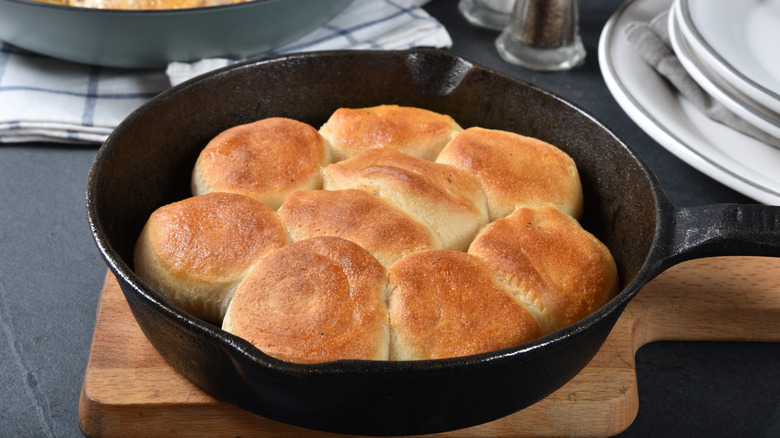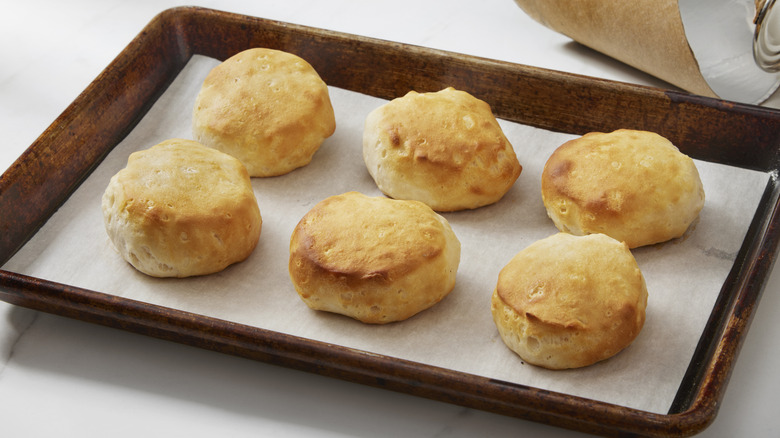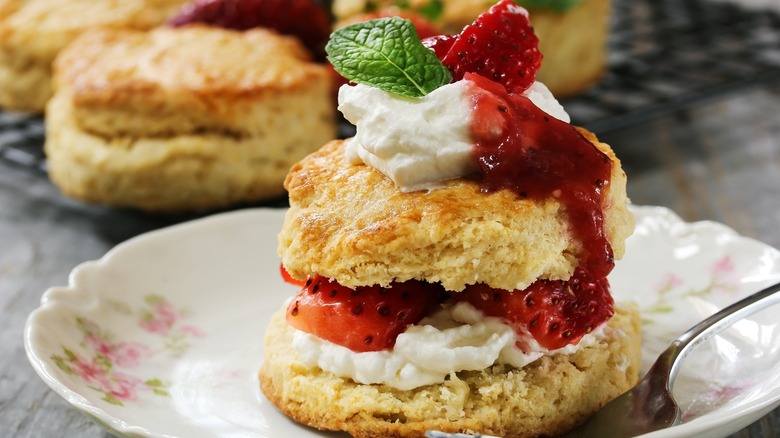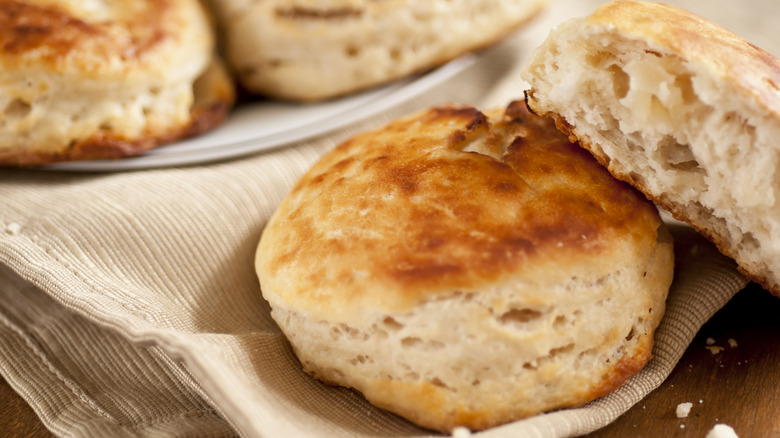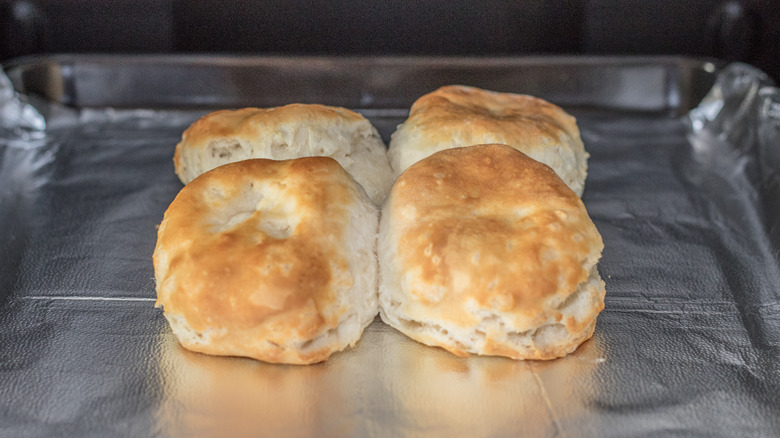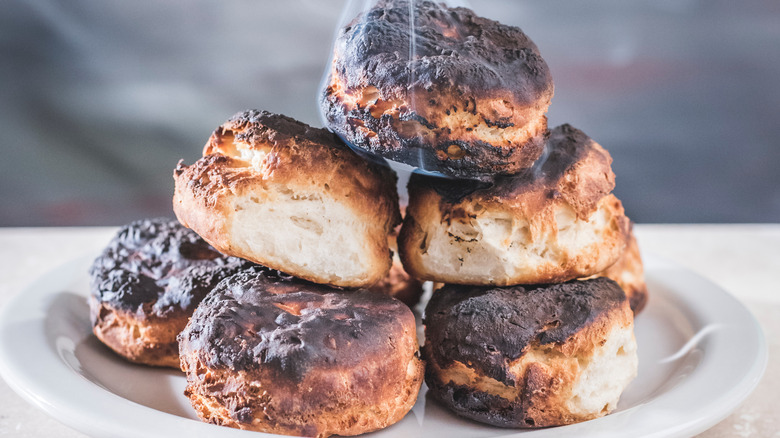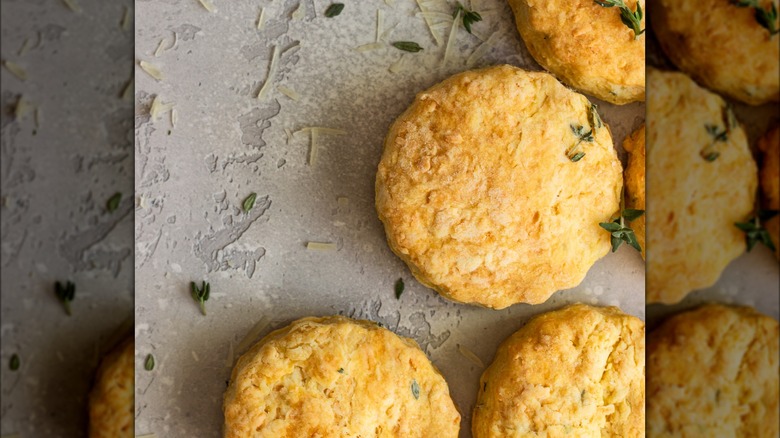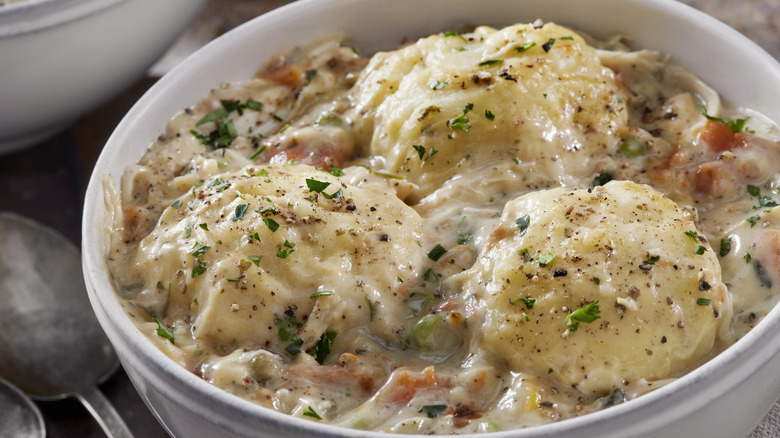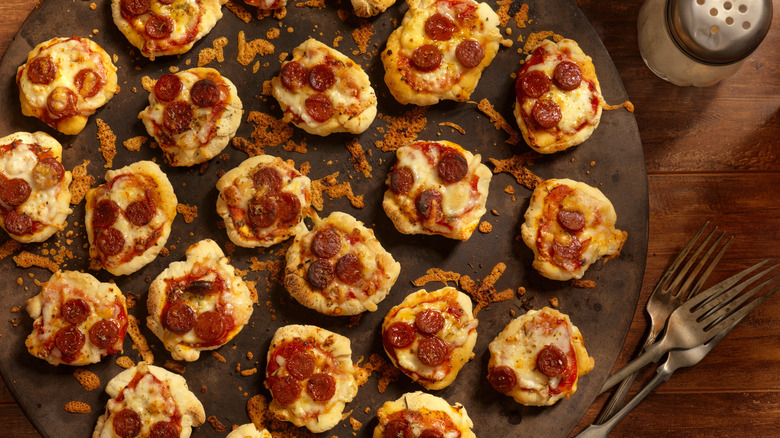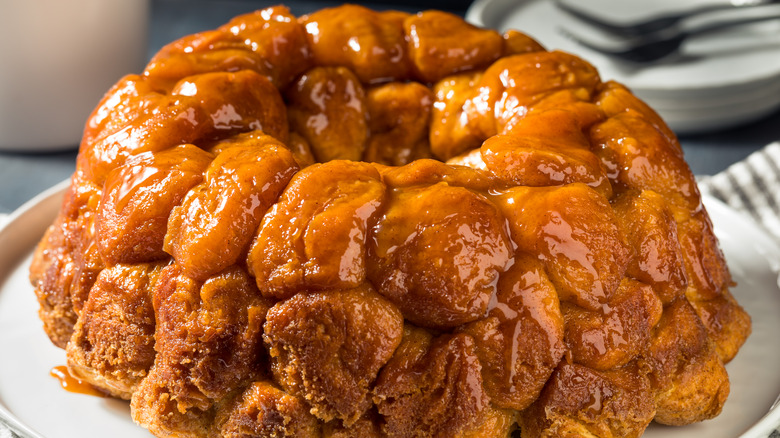12 Mistakes Everyone Makes When Using Canned Biscuits
Everyone loves a warm, flaky biscuit straight from the oven — especially if you're from the South. But making them from scratch takes time, practice, and a light hand. Mixes make a passable biscuit, but they tend to be on the fluffy side. Canned biscuits are perfect for those who enjoy decadent biscuits but are time-stressed or baking-challenged.
In their own way, these "whomp" biscuits, aptly named because you "whomp 'em" on the edge of the counter to open the package, are just about the ideal convenience product. You can extend the refrigerated product's shelf life by freezing it and thawing it. Plus, the biscuit's versatility makes it excellent for last-minute recipes or upgrading some of your favorite classic desserts. Since these biscuits are relatively bland, you can alter the flavor profile of them easily. We've gone through many a can for those reasons, even though we're experienced in crafting the perfect homemade biscuit.
Still, despite their ease of use, you can make mistakes with canned biscuits. Here are some of the most common, from errors in execution to underestimating the biscuit's value in the kitchen.
Not buying the good ones
It's never a bad idea to buy the best ingredients you can afford. Of course, in a professional kitchen, keeping food costs down is prioritized. Often, that means having to work with the ingredients we can afford rather than what we'd really like to use.
It's much the same for home cooks, but the good news is that canned biscuits — even the costlier ones — are generally pretty affordable. So, if you're going to use them, it makes sense to pick out the best brand you can buy. There are a range of different canned biscuit brands, all with different flavors and styles, so you'll just need to find one that works for you.
Not every brand will be available where you live, but there should be several in your supermarket's cooler cases to pick from. Try a couple of the higher-ranked brands, and you'll quickly discover which ones best suit your taste and your budget.
Not doing them on the stovetop
We're all pretty clear on how the process goes with canned biscuits, right? You peel the tube, smack it against the corner of your counter, jump a little as it pops (because it's startling every time, no matter how often you do it), pop the biscuits onto a sheet, and then toss them into the oven.
But the oven isn't your only option for preparing biscuits. One alternative we prefer is preparing the biscuits in a pan instead. Frying up canned biscuits in a skillet with a bit of butter gives them a deeply golden, caramelized crust, which makes a pleasing contrast with the light, flaky interior. Just separate the biscuits, fry them until well browned on the underside, then flip them and cook the second side. It takes about 15 minutes altogether, which is less time than you'd spend heating your oven and then baking conventionally.
It's an old Southern technique, and it works just as well with canned biscuits as with scratch-made. In fact, if you find you really like that crust, you can peel the canned biscuits into thinner halves to increase the ratio of golden crust to fluffy interior.
Baking the entire tube all at once
A typical tube holds eight to 10 canned biscuits. That's great if you're serving the whole family a sit-down meal because it means there will usually be at least two for everybody (and maybe one or two left over for later nibbling).
But what if there are just one or two of you? Canned biscuits are a convenience product, by definition, and if you bake the entire can from sheer habit, you aren't taking full advantage of the convenience they offer. So what if — hear us out — you bake off just the one or two you need right now and freeze the rest for later?
You can freeze and thaw canned biscuits to your heart's content, and they'll handle it beautifully, so there's no downside. Just separate the biscuits and put the ones you don't need right now on a small sheet pan. Freeze them that way, then pack them in freezer bags once they've hardened. We find that freezing the biscuits individually first keeps them from sticking together in a lump, so when you want your next biscuit, just pull out the one or two you need and pop them into the oven. You can bake them straight from frozen, with no need to thaw. Just be sure to add a couple of extra minutes to your baking time.
Not maximizing the leftover biscuits
There will be times when you'll bake more biscuits than you can eat in one sitting and have some leftovers on hand to use up. That's not a bad problem to have, but then comes the question of what to do with the biscuits.
There are dozens of creative ways to use up leftover canned biscuits. You can dice them up and toast them to make croutons, for example, for tossing onto a soup or salad. Better yet, you can use the croutons in an Italian-style panzanella salad, where they'll provide a textural contrast with the vegetables and gradually soak up the luscious, flavorful juices.
Don't forget desserts, either. Leftover biscuits make an excellent strawberry shortcake where they can be used to substitute sponge cake, for example, or you can use them as the cake element in a parfait or trifle. Don't be surprised if you find yourself baking extra on purpose, just so you can have leftovers!
Not keeping your leftover biscuits fresh
Biscuits are at their absolute best when they're fresh from the oven, but they're still pretty good even when you come back to them a couple of hours later. If you want to enjoy them for longer than that, you'll want to proactively avoid staling.
The best ways to keep biscuits fresh all revolve around minimizing their exposure to the air. There are a couple of reasons for this. Oxidation causes off-flavors and rancidity in baked goods' fats. So, minimize exposure to the air, and you'll minimize oxidation. A second reason is that the starches in your biscuits will firm up or "retrograde" as they cool, which locks up some of the biscuit's moisture. Plus, wrapping your biscuit up with plastic wrap will also prevent weird refrigerator smells from encroaching on your breakfast sandwich.
So as soon as your leftover biscuits are fully cooled, pack them into an airtight container or a bag from which you can squeeze the excess air. Or better yet, wrap them individually in foil or plastic wrap first, and then put them into a bag or container. They'll last a couple of days that way in the pantry, up to a week in the refrigerator, or for months in your freezer.
Reheating them the wrong way
There's nothing wrong with eating your leftover biscuits at room temperature, but the texture will be drier and less appealing. They're much better if they're warmed, but using the proper technique can make the difference between a biscuit that stays light and fluffy or one that resembles a warmed hockey puck.
The mistake many people make is slapping one in the microwave for whatever length of time and coming back to a leathery, over-heated biscuit. It's not that you can't enjoy a perfectly warmed biscuit from the microwave. You certainly can, but there's a distinct technique involved. Sprinkle a few drops of water on a paper towel, then wrap the damp towel around your biscuit and microwave it in increments of no more than 15 seconds until it's just hot enough. For frozen biscuits or multiple room-temperature ones, you might start with 45 seconds. But every microwave is different.
Even a perfectly microwaved biscuit loses its delicate crust, so we recommend using a dry-heat method to reheat your biscuits instead. Rewarming them in your oven or toaster oven for about five minutes will do the trick. Brush them first with butter, if you like, to help keep them moist. Alternatively, you can heat them in a pan, either as-is or wrapped in foil first to trap moisture, which can be even faster. Either way, you'll enjoy a tasty biscuit that's closer to fresh-baked than if you used a microwave.
Always using your big oven, rather than smaller alternatives
When we want to bake something — anything — most of us automatically crank up our main oven. Regardless of the size and location of your oven, the thing these appliances have in common is that they represent a large space that needs to be heated before baking can begin.
Unless your oven is already in use, is it worth heating it up for a small pan of biscuits? You might think twice about this in the summer when you'll need to crank the air conditioning to compensate for the heat blaring from your oven. Most of us have a smaller alternative already available in our kitchens in the form of a toaster oven, countertop convection oven, or air fryer.
According to a report published by the Environmental Protection Agency, a toaster oven uses as little as half the power of your regular oven, which can add up to a significant difference in your energy bill over a year. Air fryers are also highly efficient, and their even more compact size makes them ideal for baking a biscuit or two at a time. As a bonus, because these are all quicker to preheat than your main oven, they'll put biscuits on your plate just that little bit faster.
Not adapting your baking time and temperature to the appliance you're using
Canned biscuits are a near-perfect candidate for baking in a toaster oven, a countertop convection oven, or even an air fryer. A full can of biscuits will usually fit just fine on a toaster oven-sized pan, and even an air fryer can handle enough biscuits for one or two people.
That being said, there are a couple of potential pitfalls to cooking with these appliances. For one thing, the burner of a toaster oven is closer to your biscuits than it would be in your regular oven and can cause them to brown too quickly. One tip to use when cooking with a toaster oven is to lower the rack to offset the temperature difference. Preheating also helps since the top element won't be blaring heat as much. Sometimes, we find that no adjustment will help. In that case, you can simply cover the biscuits with a sheet of foil once they're nicely browned.
In a convection oven, you'll usually need to lower the temperature by about 25 F and may need to rotate your pan to account for unequal heating. Air fryers vary in power and size, so you should refer to your manual or manufacturer's website for guidance on temperature and cooking time adjustment.
Not taking advantage of simple upgrades
Canned biscuits are ... fine. They're perfectly acceptable. They're good enough. But why would you settle for "good enough" when it's relatively easy to make them better?
There are any number of upgrades you can do with canned biscuits that take next to no time but still give you a better and tastier result. For example, it takes just a moment to elevate your canned biscuits with a slice of cheese. Just pull each biscuit apart, put the cheese in the middle, replace the top half, and bake normally.
Another simple upgrade comes from brushing the biscuits with cream or melted butter, which improves their flavor and gives them a more golden color. Better yet, brush them with an infused or compound butter to amp up the flavor. If you really want to go all-out, you can even make savory biscuit cupcakes by peeling apart the layers and stacking them in muffin tins with bold-flavored ingredients tucked in between.
Not using them as dumplings
Biscuits and dumplings are close kin. A light, fluffy dumpling is very similar to a "drop" biscuit, though, of course, its texture is different because the former cooks in a pot full of simmering, steaming soup or stew rather than in a dry oven.
Of course, as with biscuits, not everyone has the practiced hand needed to make light and fluffy dumplings. All too often, they come out as lumpy, doughy cannonballs instead. Well, canned biscuits are a quick solution to this problem. They're always light, and using them as dumplings is just as easy and convenient as baking them for biscuits.
Open the can, separate the biscuits, and cut them up into small, spoon-sized pieces. Then simply add them to your simmering pot of chicken and dumplings, beef stew, or a favorite soup, and clap the lid on to trap the hot, steamy air. In a few minutes, depending on how large you've cut them, your dumplings will be ready to eat.
Not leveraging them for quick meal ideas
Biscuits aren't ever going to be the main component of your meal unless it's a Southern plate of biscuit and gravy. Sopping up gravy is one of the biscuit's most fundamental uses — and they're good at it. But you're missing out if you don't explore other ways canned biscuits can be used for quick, family-friendly meals. In fact, it's one way the canned variety may be better than the ones from scratch.
When you need a quick mid-week meal, for example, consider cracking open a tube to make quick mini pizzas. Just roll each biscuit to flatten and enlarge it, and season it as you wish. Par-bake them for a few minutes so they won't be doughy; add your toppings, and return them to the oven until they're done. You can also turn them into pizza pockets by loading the flattened circles of dough with your favorite toppings, then folding them over and sealing the edges.
You can use the same technique for other hand pies, whether savory (filled with canned or leftover stew, perhaps) or sweet with fresh fruit or prepared pie filling. You can even create a whole breakfast sandwich in a biscuit, rather than on a biscuit, by packing cheese and breakfast meats between the layers and then sealing the edges before baking.
Not exploring their dessert potential
Canned biscuits can also answer questions like "Do we have any treats to put in my lunch?" or "What are we going to have for dessert?" A canned biscuit, after all, is just a light and flaky pastry. All you need to do, if you want to call it dessert, is to steer that flaky goodness in a sweet direction.
One of the easiest options is simply to roll your canned biscuits in cinnamon sugar before you bake them. It turns them into the quickest breakfast pastry imaginable. If you want to take that same basic idea to its logical conclusion, you could cut the biscuits into quarters, roll them in cinnamon sugar, and then stack them into a Bundt pan with caramel sauce to make monkey bread.
Use your canned biscuits as the crust on a cobbler, with seasonal fresh fruit or a prepared pie filling. Alternatively, you can use the same ingredients for bubble up desserts, where you combine the fruit and cut-up biscuits together. The biscuit pieces rise up through the fruit to form a crust, with the hot fruit bubbling in between. The flavors are much the same as with a cobbler, but the texture is more pudding-like, and you don't get separate layers of biscuit and filling.


